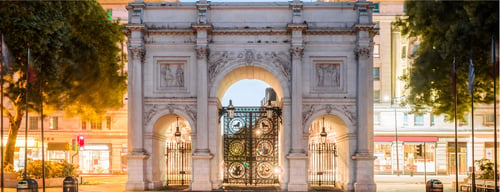
Our hotels near Marble Arch
Join ALLBecome a member of the loyalty program ALL and get a discount in more than 3,000 hotels starting with your first reservation
Filter by:
Hotel Rating
Brands
Facilities
Marble Arch
The Marble Arch is a 19th-century London landmark set in the middle of the Borough of Westminster, on the corner of Hyde Park. This marble-faced triumphal arch is a must-see for history or architecture lovers in London.
Browse Hotels in Marble Arch
Mercure London Hyde Park Hotel
4,1/5888 ReviewsImmerse yourself in the refined comfort of Mercure London Hyde Park, where historic elegance and contemporary convenience converge. Nestled by the iconic park and minutes from Paddington station, our hotel boasts smart tech, bespoke interiors, and thoughtful amenities. Relish the ease of flexible bookings and savor the tranquility of your London retreat. Discover your urban sanctuary with us.
Book Mercure London Hyde Park HotelMercure London Paddington Hotel
3,7/51078 ReviewsThe 4-star Mercure London Paddington hotel blends contemporary design with the convenience of being in central London. Located next to Paddington station, this stylish hotel offers state-of-the-art facilities to help make your stay a welcome one. Its serene setting offers a contrast to the hustle and bustle of the city, with each room providing guests with the comforts of home and more. The hotel comes equipped with a 24-hour gym, while the on-site restaurant serves food and drinks all day.
Book Mercure London Paddington HotelNovotel London Paddington
4,2/52319 ReviewsDiscover the very best that the capital has to offer at our Novotel London Paddington hotel with contemporary stylings, a fitness centre and a heated swimming pool. Novotel London Paddington is perfect base for guests travelling alone or as a family due to the ideally location for exploring the famous landmarks of London, with easy access to Hyde Park , Regent's Park and shopping heaven Oxford Street, this way you can complete your vacation stress free.
Book Novotel London PaddingtonMercure London Bloomsbury Hotel
4,0/52663 ReviewsMercure London Bloomsbury, located in the famous Bloomsbury area, with its wide range of restaurants, cafes and bars to suit all taste. This hotel is a great base for exploring the best of the West Ends shopping, Theatres and all of the prominent London tourist attractions. The British Museum, Covent Garden and Oxford Street are all a short walk away . The hotel is a 5 minute walk from Holborn and Russel Square Tube stations making connections with Heathrow and St. Pancras for the Eurostar simple
Book Mercure London Bloomsbury HotelPullman London St Pancras
4,5/53873 ReviewsThe Pullman London St Pancras hotel is ideally located just a few minutes walk from three of the city's major railway station, Kings Cross, Euston and St Pancras International. Guests arriving on business will find this the perfect destination, with 17 contemporary meeting rooms capable of holding conferences and functions. The hotel is one of the city premier upscale destinations, with a host of luxury amenities and offerings such as tranquil rain showers and more.
Book Pullman London St Pancras